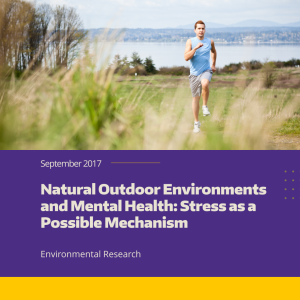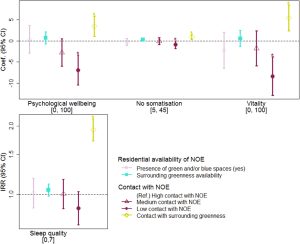Natural Outdoor Environments and Mental Health: Stress as a Possible Mechanism
Citation
Triguero-Mas, M., Donaire-Gonzalez, D., Seto, E., Valentín, A., Martínez, D., Smith, G., … & Nieuwenhuijsen, M. J. (2017). Natural outdoor environments and mental health: Stress as a possible mechanism. Environmental Research, 159, 629-638. doi.org/10.1016/j.envres.2017.08.048
 Using novel measures, researchers explored the relationship between spending time in natural outdoor environments and people’s mental health. They gathered data from 406 adults living in four European cities: Barcelona, Spain; Stoke-on-Trent, United Kingdom; Doetinchem, Netherlands; Kaunas, Lithuania. Researchers measured how much nature was available around the participants’ homes using mapping tools. They also used smartphone data to see how often participants actually spent time in nature over the course of a week. Participants also completed surveys about their mental well-being, sleep, energy levels, and physical symptoms, along with information about stress, social interactions, and daily physical activity.
Using novel measures, researchers explored the relationship between spending time in natural outdoor environments and people’s mental health. They gathered data from 406 adults living in four European cities: Barcelona, Spain; Stoke-on-Trent, United Kingdom; Doetinchem, Netherlands; Kaunas, Lithuania. Researchers measured how much nature was available around the participants’ homes using mapping tools. They also used smartphone data to see how often participants actually spent time in nature over the course of a week. Participants also completed surveys about their mental well-being, sleep, energy levels, and physical symptoms, along with information about stress, social interactions, and daily physical activity.
While simply living near more natural spaces did not show a clear link to better mental health, actually spending time in nature did. People with more direct contact with nature — especially those surrounded by greenery — tended to report better mental health. These benefits appeared stronger for men, younger people, people with lower to medium education levels, and residents of Doetinchem. Lower stress levels helped explain most of the positive effects, while physical activity and social contact did not.
Overall, the results suggest that making time to be in nature supports mental health, particularly when those experiences help reduce stress.
Abstract

Introduction: Better mental health has been associated with exposure to natural outdoor environments (NOE). However, comprehensive studies including several indicators of exposure and outcomes, potential effect modifiers and mediators are scarce.
Objectives: We used novel, objective measures to explore the relationships between exposure to NOE (i.e. residential availability and contact) and different indicators of mental health, and possible modifiers and mediators.
Methods: A nested cross-sectional study was conducted in: Barcelona, Spain; Stoke-on-Trent, United Kingdom; Doetinchem, Netherlands; Kaunas, Lithuania. Participants’ exposure to NOE (including both surrounding greenness and green and/or blue spaces) was measured in terms of (a) amount in their residential environment (using Geographical Information Systems) and (b) their contact with NOE (using smartphone data collected over seven days). Self-reported information was collected for mental health (psychological well-being, sleep quality, vitality, and somatisation), and potential effect modifiers (gender, age, education level, and city) and mediators (perceived stress and social contacts), with additional objective NOE physical activity (potential mediator) derived from smartphone accelerometers.
Results: Analysis of data from 406 participants showed no statistically significant associations linking mental health and residential NOE exposure. However, NOE contact, especially surrounding greenness, was statistically significantly tied to better mental health. There were indications that these relationships were stronger for males, younger people, low-medium educated, and Doetinchem residents. Perceived stress was a mediator of most associations, and physical activity and social contacts were not.
Conclusions: Our findings indicate that contact with NOE benefits mental health. Our results also suggest that having contact with NOE that can facilitate stress reduction could be particularly beneficial.